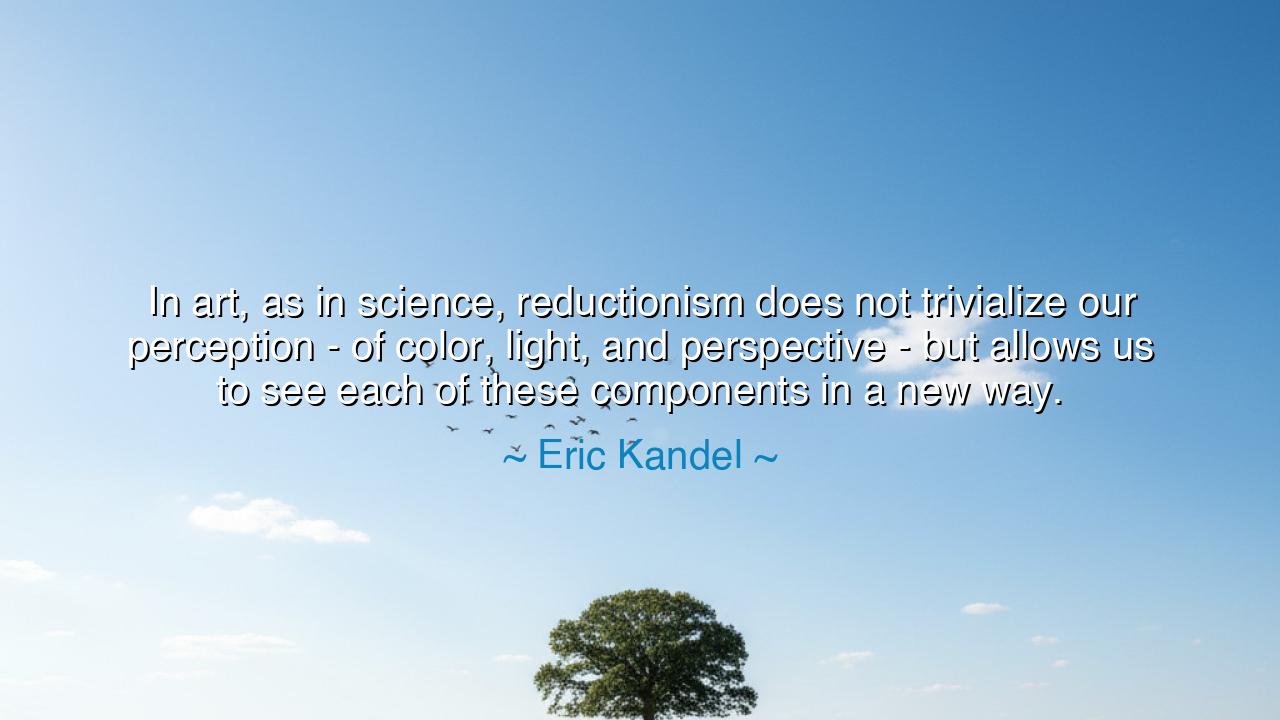
In art, as in science, reductionism does not trivialize our
In art, as in science, reductionism does not trivialize our perception - of color, light, and perspective - but allows us to see each of these components in a new way.






Hearken, O children of wisdom, to the voice of Eric Kandel, the seeker of mind and memory, who declared: “In art, as in science, reductionism does not trivialize our perception—of color, light, and perspective—but allows us to see each of these components in a new way.” These words rise like a bridge between two mighty rivers, for they unite the realm of art and the realm of science, teaching us that the breaking down of the whole into its parts is not destruction but revelation. To see clearly, we must sometimes strip the garment from the body, not to diminish its beauty, but to behold the truth that makes it shine.
Consider the painter, who gazes upon the world and sees it not only as a whole, but as fragments of color, threads of light, and angles of perspective. When he places red beside blue, shadow beside brightness, he teaches the eye to see differently. This is no trivial act, no cheapening of the world’s majesty. Rather, it is a magnification of its mystery. So too the scientist, who looks into the living cell, the atom, or the particle, and by dividing them into smaller truths, enlarges the kingdom of knowledge. Thus, the act of reduction is not an insult to beauty, but its deepest reverence.
History itself bears witness to this union of division and discovery. Recall the tale of Isaac Newton, who beheld the white light of the sun and dared to pass it through a humble prism. In that moment of reduction, the blazing unity of the heavens was revealed to be a rainbow of hidden colors. Did he trivialize the sunlight by breaking it apart? Nay! He exalted it, showing mankind that within one radiance dwelt a symphony of hues. What the eye once saw as singular, the spirit now saw as manifold, each part carrying its own secret beauty.
Likewise, in the realm of art, the Impressionists broke from tradition and sought to depict the world not with rigid form, but with fragments of light and color laid bare upon the canvas. To some, it seemed a reduction, a dismissal of structure. Yet in truth, they taught the world to see again—to see movement in a flicker, depth in a shadow, brilliance in a stroke. Monet’s lilies, shimmering with broken light, were not lesser visions of nature, but revelations of how nature appears when bathed in the living breath of perception.
Kandel speaks, therefore, to a universal law: that to analyze is not to desecrate. When the mind divides, it does not destroy—it uncovers. The flower, dismantled in the botanist’s hand, is still the flower, but now its veins, its pollen, its hidden gears of life are made visible. The symphony, studied note by note, still resounds, but now its harmonies are better understood, its structure more deeply admired. To break apart is not always to weaken; sometimes it is to strengthen vision, to deepen awe.
Yet let the seeker beware: reduction must not lead to blindness. If we stop at the fragments and forget the whole, we lose the spirit that binds them. To see light as color only, or perspective as geometry only, is to miss the majesty of their union. Thus, wisdom lies in moving between the parts and the whole, seeing both the stone and the temple it builds, both the brushstroke and the masterpiece it creates.
What then, beloved listeners, is the lesson for your life? It is this: when you face the vast and the complex, do not despair. Break it into parts, examine each, and you will discover clarity. Approach your challenges as both the artist and the scientist. See the details, the small steps, the building blocks of greatness, and then return to the whole, wiser for your journey.
Therefore, in your daily toil, when fear of complexity clouds your mind, remember Kandel’s wisdom: reduction does not trivialize, it illuminates. Be not afraid to divide the mighty into the manageable, the overwhelming into the approachable. For in seeing each part anew, you will not only solve the mystery—you will also stand in greater awe of the whole.






AAdministratorAdministrator
Welcome, honored guests. Please leave a comment, we will respond soon